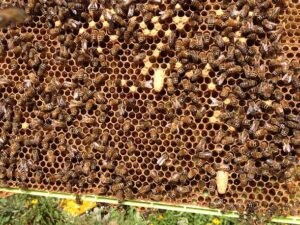One of our newbees embarrassingly said he “made a mistake” by not getting into his hive for about a month. He found the second box almost fully drawn, with lots of capped brood and capped honey. (He also saw bees emerging, always amazing to catch that.)
I don’t think it was a mistake—with Michigan’s monsoon season, the weather doesn’t always cooperate when you have the time. We’re working a couple dozen hives, and oopsie—we’ve opened a few in the last few weeks that we also should’ve opened earlier. Last time we checked they had 3-4 frames of capped brood, and this time, the queen’s twiddling her thumbs wondering where she’s supposed to put eggs as everything is filled with bees-to-be or honey. (That’s called honeybound.) So sorry Queenie! And thanks for not swarming on us. We quickly got another box on each of those hives.
A deep frame can hold several thousand bees … so when you have 3-4 frames of capped brood, and they hatch and get to work, production ramps up quickly. Stay ahead of them this lush time of year; there’s plenty for them to bring in and bees were born to make honey.
When you add a box: If your boxes are the same size, move a few frames of brood to the upper box to encourage them to work it also.
Remember, you don’t need to find the queen, but you should always look for evidence of the queen (EoQ)–eggs or larva. Finding eggs mean you had a queen within the last three days; she’s probably still there. Finding larva means within the last 8 days, so check again in about a week to find EoQ again if you’re suspicious she might not be there (more aggressive behavior, or capped queen cells.) You don’t want a hive to be queenless for too long or a laying worker could develop.

